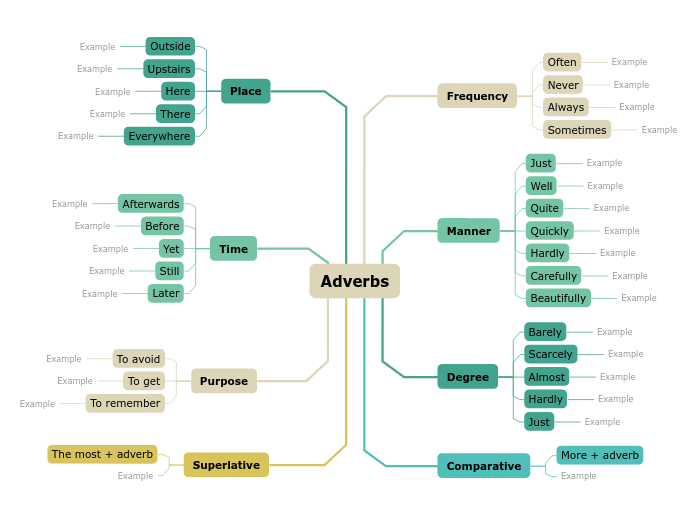English Adverbs Examples
Use this mind map to improve your understanding of how adverbs are used and practice by creating different contexts.
Keywords: grammar, language


Mehr dazu
Adverbs are the parts of speech that describe verbs, adjectives, or other adverbs, phrases, clauses, or sentences.
There are different types of adverbs:
Adverbs of frequency
Adverbs of manner
Adverbs of degree
Comparative adverbs
Superlative adverbs
Purpose adverbs
Time adverbs
Place adverbs
Adverbs of frequency present how frequently or how often verbs happen. Some examples of adverbs of frequency are:
Often
Never
Always
Sometimes
Adverbs of manner provide information about the way the verb is done. Some examples of adverbs of manner are:
Just
Well
Quite
Quickly
Hardly
Carefully
Beautifully
Adverbs of degree provide information about the level of intensity of verbs, adjectives, or other adverbs. Some examples of adverbs of degree are:
Barely
Scarcely
Almost
Hardly
Just
Comparative adverbs are used to show change or make comparisons. Comparative adverbs are formed by adding the word ‘more’ to adverbs.
Adverbs of purpose express the reason of verbs. Some examples of adverbs of purpose are:
To avoid
To get
To remember
Adverbs of time offer information about the time when the verb takes place. Some examples of time adverbs are:
Afterwards
Before
Yet
Still
Later
Adverbs of place offer information about the place where the verb takes place. Some examples of adverbs of place are:
Outside
Upstairs
Here
There
Everywhere
Adverbs are words or expressions that modify a verb, adjective, another adverb, determiner, clause, preposition, or sentence. Adverbs typically express manner, place, time, frequency, degree, level of certainty, etc.
Compares three or more things or people, usually is compounded of the words 'the most' plus adverb.
Answers the question:
Answers the question:
Answers the question:
Compares two things or people, usually is compounded of the word 'more' plus adverb.
Answers the question:
Answers the question:
Answers the question:
Write phrases as examples.
Mind Maps helfen Ihnen beim Brainstorming, beim Herstellen von Beziehungen zwischen Konzepten sowie beim Organisieren und Generieren von Ideen.
Mindmap-Vorlagen bieten jedoch einen einfacheren Einstieg, da es sich um Rahmen handelt, die Informationen zu einem bestimmten Thema mit Leitanweisungen enthalten. Im Wesentlichen sorgen Mindmap-Vorlagen für die Struktur, die alle Elemente eines bestimmten Themas vereint und als Ausgangspunkt für Ihre persönliche Mindmap dient. Sie sind eine Ressource für die Bereitstellung einer praktischen Lösung zum Erstellen einer Mindmap zu einem bestimmten Thema, sei es für Unternehmen oder für den Bildungsbereich.
Mindomo bietet Ihnen intelligente Mindmap-Vorlagen, mit denen Sie mühelos arbeiten und denken können.
Beschreibende Themen
Themen mit Hintergrundtext
Standardzweig
Entfernen der Vorlagendaten
Sie können aus einer Vielzahl von Mindmap-Vorlagen aus den Geschäfts- oder Bildungskonten von Mindomo wählen oder Ihre eigenen Mindmap-Vorlagen von Grund auf erstellen. Jede Mindmap kann in eine Mindmap-Vorlage umgewandelt werden, indem einem ihrer Themen weitere Leitnotizen hinzugefügt werden.